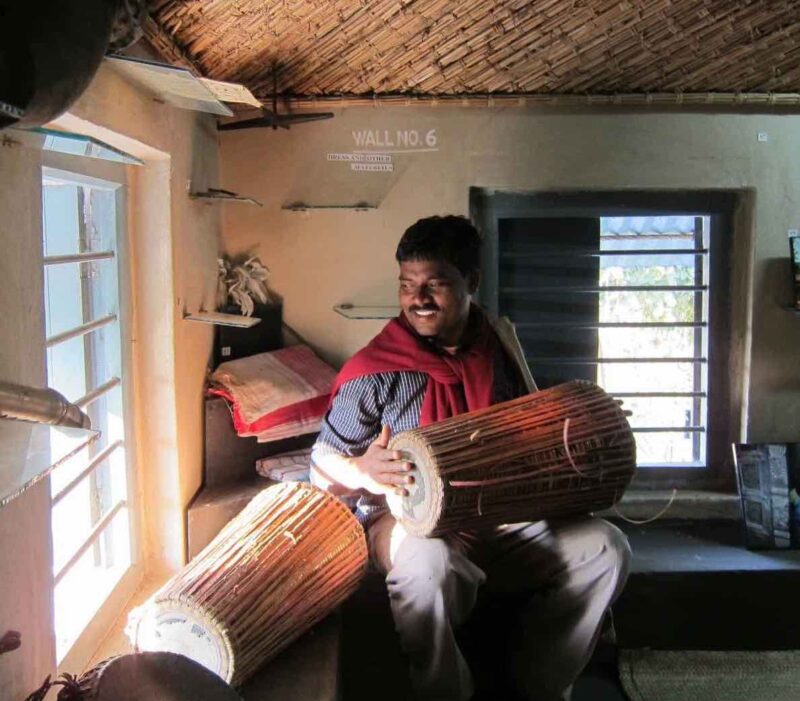
“The goal is to prepare some model students in our villages, so that others will be inspired to follow them.” – Boro Baski in Long-term success of non-formal Adivasi school in West Bengal
Between 2008 and 2022, the Tribal Cultural Heritage in India Foundation supported projects by tribal communities keen on preserving their cultural heritage in tandem with modernization of education and education; and this as citizens of a democratic and secular country. At the same time, the foundation has sought to foster greater sensitivity in debates about assimilation and the use of one’s mother tongue.
We are so much more than that. We follow a tradition rich in music, dance and love. – Swarnalatha, who now runs an NGO that works for the upliftment for people of her tribal Irula community (known for their snake-catching skills), quoted in “Irulas much more than a community of snake catchers” timesofindia.indiatimes.com (23 February 2018)
More women in tribal communities deserve to qualify as teachers, scholars, engineers, entrepreneurs and health professionals – to name but a few of the career choices available to their “mainstream” peers today. Making informed choices is the key to their standing in the modern world. | Learn more on tribal migration and economic growth >>
At the heart of all the violations of our human rights has been the failure to respect our integrity, and the insistence on speaking for us, defining our needs and controlling our lives. – Karbi leader Dharamsing Teron [1]
Showcasing tribal culture is bound to benefit young people from other cultural backgrounds as well. This strengthens cultural diversity as enshrined in the Indian constitution and affirmed in the United Nations 2007 declaration that brought to an end nearly 25 years of contentious negotiations over the rights of native people to protect their lands and resources, and to maintain their unique cultures and traditions. [2]
Such values also underly Unesco’s programmes such as the Safeguarding Intangible Cultural Heritage of Mankind [3]:
The term ‘cultural heritage’ has changed content considerably in recent decades, partially owing to the instruments developed by UNESCO. Cultural heritage does not end at monuments and collections of objects. It also includes traditions or living expressions inherited from our ancestors and passed on to our descendants, such as oral traditions, performing arts, social practices, rituals, festive events, knowledge and practices concerning nature and the universe or the knowledge and skills to produce traditional crafts.
While fragile, intangible cultural heritage is an important factor in maintaining cultural diversity in the face of growing globalization. An understanding of the intangible cultural heritage of different communities helps with intercultural dialogue, and encourages mutual respect for other ways of life.
Sources:
[1] Teron, Dharamsing. Reclaiming the Ancestors’ Voices: Karbi Studies Vol. 2. Guwahati: Book Hive, 2011; quoted by Meenaxi Barkataki-Ruscheweyh in Performing Ethnicity to Resist Marginalisation: The Tangsa in Assam. PhD thesis. Amsterdam: Vrije Universiteit, 2015 (p. 220).
[2] UN Department of Public Information (New York, 13 September 2007)
http://www.un.org/News/Press/docs/2007/ga10612.doc.htm
Date Visited: 29 March 2011
[3] What is Intangible Cultural Heritage? (Unesco homepage)
https://ich.unesco.org/en/what-is-intangible-heritage-00003
Date Visited: 15 May 2011
“[T]he Constitution gives equal respect to all communities, sects, lingual and ethnic groups, etc. The Constitution guarantees to all citizens freedom of speech (Article 19), freedom of religion (Article 25), equality (Articles 14 to 17), liberty (Article 21), etc.” – Supreme Court judgment quoted by The Hindu in “India, largely a country of immigrants” >>
In Marginalised but not Defeated, Tarun Kanti Bose (a seasoned public interest journalist) “documents the hard and difficult struggle to implement the Forest Rights Act, how the oppressed adivasis have united into forest unions, how they are now entering into new thresholds of protracted struggles and victories in a non-violent manner. […] A must for all young journalists, social science students, editors, civil society groups and the academia.” | Read the full book review here:
https://countercurrents.org/2023/05/book-review-marginalised-but-not-defeated >>
Learn more about “The world’s largest democracy“, its Constitution and Supreme Court and linguistic heritage, and why Democracy depends on Accountability in the face of Modernity and Globalization >>
See also
Adivasi Academy & Museum of Adivasi Voice at Tejgadh | Lecture “A View of Higher Education in India”
Appropriate education for Adivasi children – the Vidyodaya School model at Gudalur
Childhood | Children’s books | Childrens rights: UNICEF India | Safe search
People’s Linguistic Survey of India | Volumes (PLSI) | PeoplesLinguisticSurvey.org
Multi-lingual education | Residential school | Ekalavya
Multilingual education is a pillar of intergenerational learning – Unesco
Santali education | Teaching Santal children by Boro Baski
Unesco | Unicef | Unicef India | United Nations
United Nations International Days and Weeks
Video | “Nations don’t make us human – languages make us human”: Ganesh Devy
Women | Safe search | President Droupadi Murmu on women’s empowerment